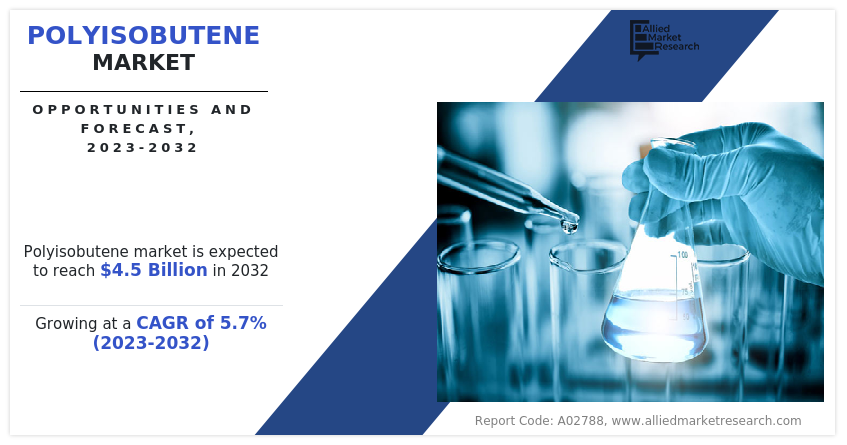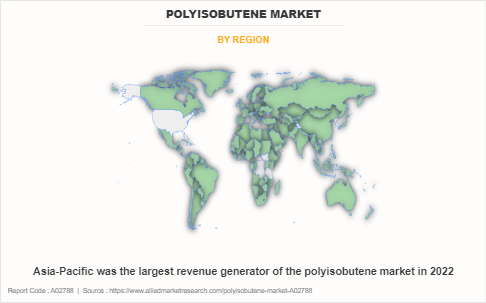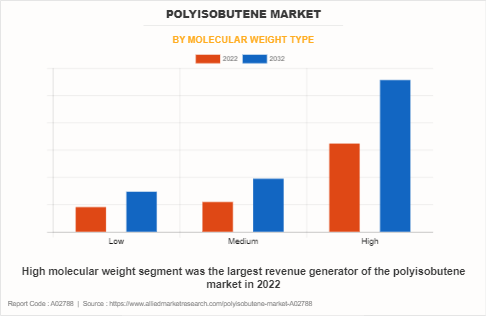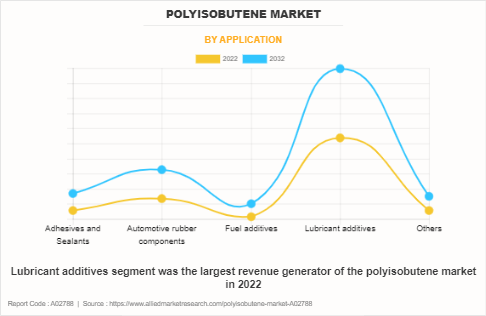Polyisobutene Market Research, 2032
The global polyisobutene market was valued at $2.6 billion in 2022, and is projected to reach $4.5 billion by 2032, growing at a CAGR of 5.7% from 2023 to 2032.
Key Report Highlighters:
- Global polyisobutene market is fragmented in nature with many players such as Lubrizol Corporation, BASF, TPC Group, Lanxess AG, Reliance Industries, Sibur, Exxon Mobil, INEOS, and Daelim. It also includes key strategies such as product launches, acquisitions, mergers, and expansion adopted by various manufacturers of Polyisobutene.
- Included more than 20 countries in the report which covers market volume as well as market value for all the countries of the Polyisobutene market.
- Covered the detailed list of manufacturers by application of the Polyisobutene market. It covers the product information, application, and geographical presence of the companies.
- Conducted primary interviews with raw material suppliers, wholesalers, suppliers, and manufacturers of the Polyisobutene market to understand the market trends, growth factors, pricing, and key players competitive strategies, and market forecast.

Polyisobutene (PIB) is a type of polymer that belongs to the class of polyolefins. It is a versatile polymer with applications in various industries, including the automotive, lubricants, and adhesives sectors. The Asia-Pacific region, comprising countries such as China, India, Japan, South Korea, and others, has witnessed significant growth in the use of polyisobutene. Polyisobutene is commonly used in the automotive industry as an additive in lubricants and fuel. It helps improve the viscosity index of lubricating oils and enhances the performance of automotive engine oils.
The growing automotive sector in the Asia-Pacific region contributes to the demand for PIB-based products. In the adhesives and sealants industry, PIB is used as a tackifier and adhesive promoter. It enhances the performance of adhesives by providing improved tackiness and adhesion. The demand for adhesives and sealants containing PIB may increase with increase in construction and manufacturing activities in the Asia-Pacific region.
Furthermore, the Asia-Pacific region has experienced significant industrial growth and development, particularly in countries like China and India. This growth has led to increased demand for various chemicals and polymers, including polyisobutene, for use in industrial processes and applications. Moreover, PIB-based products may find applications in the packaging industry, such as in the manufacturing of adhesives for packaging materials.
The growth of the polyisobutene market can be attributed to several factors that contribute to the increase in demand for this polymer in various industries. Polyisobutene is widely used in the manufacturing of tires due to its ability to improve tire performance, durability, and fuel efficiency. There is an increase in the demand for high-performance tires and related products with the expansion of the global automotive industry. This contributes toward the growth of the polyisobutene market. The construction and automotive industries heavily rely on adhesives and sealants, where impermeable and adhesive properties of polyisobutene are valuable. The growth in these sectors, driven by urbanization and infrastructure development, fuels the demand for polyisobutene.
Increased demand for polyisobutene in automotive industry
The increased demand for polyisobutene in the automotive industry is driven by its use in the manufacturing of tires and other applications that contribute to improved performance, durability, and fuel efficiency. One of the primary uses of polyisobutene in the automotive industry is in the production of tires. Polyisobutene is added to tire formulations to enhance the tire's properties, such as tread flexibility, wear resistance, and rolling resistance. These improvements contribute to better overall tire performance and fuel efficiency.
Polyisobutene can be used to reduce rolling resistance in tires. Lower rolling resistance means less energy is required to propel the vehicle forward, leading to improved fuel efficiency. This is particularly important as the automotive industry focuses majorly on sustainability and fuel economy. The addition of polyisobutene in tire formulations improves the durability and lifespan of tires. This is crucial for vehicle safety and cost-effectiveness, as durable tires require less frequent replacement.
In addition, polyisobutene can enhance the wet traction of tires, providing better grip on wet roads. This is important for overall road safety, especially in regions with diverse weather conditions. Polyisobutene can contribute to reducing vibrations in tires, leading to a smoother and more comfortable ride. This is an important factor in the automotive industry as manufacturers focus on enhancing the driving experience.
Moreover, polyisobutene's impermeable and adhesive properties make it valuable in the production of sealants and adhesives used in automotive applications. This includes sealing components to prevent leaks and providing effective bonding in various parts of the vehicle. Moreover, polyisobutene can be used for sound and thermal insulation in vehicles. Its ability to form a barrier against gases and moisture makes it suitable for creating insulated materials that contribute to a quieter and more comfortable cabin environment.
The use of polyisobutene in tire formulations can contribute to reducing the environmental impact of vehicles by improving fuel efficiency. The demand for materials that enhance fuel efficiency is on the rise as automotive manufacturers focus on sustainability and reducing carbon emissions.
The combination of these factors makes polyisobutene a valuable material in the automotive industry, contributing to improved vehicle performance, safety, and environmental sustainability. The demand for polyisobutene is likely to grow further with developments in the automotive sector.
The polyisobutenes market is segmented into molecular weight, application, and region. By molecular weight, the market is segregated into low, high, and medium. By application, the market is fragmented into adhesives & sealants, automotive rubber components, fuel additives, lubricant additives, and others. Region-wise, the market is studied across North America, Europe, Asia-Pacific and LAMEA.
The major players operating in the polyisobutene market include Lubrizol Corporation, BASF, TPC Group, Lanxess AG, Reliance Industries, Sibur, Exxon Mobil, INEOS, and Daelim. These players have adopted product launch as their key strategy to increase their market shares.

Region-wise, the polyisobutene market is analyzed across North America, Europe, Asia-Pacific, and LAMEA. The Asia-Pacific polyisobutene market size is projected to expand at the highest CAGR of 6% during the forecast period. The Asia-Pacific region is a major hub for the automotive industry, with significant production and consumption of vehicles. Polyisobutene is widely used in tire manufacturing and automotive lubricants, contributing to the growth of the market.

Based on molecular weight, the market is divided into low, high and medium. In 2022, the high molecular weight segment was the largest revenue generator of the polyisobutene marke and it is expected to grow at a CAGR of 5.7% during the forecast period. HMW PIB is often used as a viscosity modifier in lubricating oils and grease. Its high molecular weight allows it to effectively control the viscosity of these lubricants, providing enhanced stability and performance over a wide range of temperatures. There is a growing demand for lubricants with improved viscosity characteristics as industrial machinery and automotive engines continue to advance.

Based on application, the global polyisobutene market is fragmented into adhesives & sealants, automotive rubber components, fuel additives, lubricant additives, and others. Lubricant additives was the largest revenue generator, in 2022 and is anticipated to expand at a CAGR of 5.7% during the forecast period. Polyisobutene can be used as a viscosity modifier in lubricating oils. It helps control the viscosity of the oil, ensuring that it maintains optimal flow and lubricating properties across a range of temperatures. This is crucial for industries where machinery operates in diverse and challenging environments.
Key Benefits For Stakeholders
- This report provides a quantitative analysis of the market segments, current trends, estimations, and dynamics of the polyisobutene market analysis from 2022 to 2032 to identify the prevailing polyisobutene market opportunities.
- The market research is offered along with information related to key drivers, restraints, and opportunities.
- Porter's five forces analysis highlights the potency of buyers and suppliers to enable stakeholders make profit-oriented business decisions and strengthen their supplier-buyer network.
- In-depth analysis of the polyisobutene market segmentation assists to determine the prevailing market opportunities.
- Major countries in each region are mapped according to their revenue contribution to the global market.
- Market player positioning facilitates benchmarking and provides a clear understanding of the present position of the market players.
- The report includes the analysis of the regional as well as global polyisobutene market trends, key players, market segments, application areas, and market growth strategies.
Polyisobutene Market Report Highlights
| Aspects | Details |
| Market Size By 2032 | USD 4.5 billion |
| Growth Rate | CAGR of 5.7% |
| Forecast period | 2022 - 2032 |
| Report Pages | 120 |
| By Molecular Weight Type |
|
| By Application |
|
| By Region |
|
| Key Market Players | Daelim Industrial Co. Ltd, Lubrizol Corporation, INEOS Group AG, TPC Group, Inc., DXTG Nippon Oil and Energy Corporation, SIBUR, Exxon Mobil Corporation, Reliance Industries, Lanxess AG, BASF SE |
Analyst Review
According to CXO perspective, high molecular weight polyisobutene is utilized in the tire industry to enhance certain properties of rubber compounds. It can improve the tackiness of rubber, contributing to better adhesion between tire components. In addition, it can be used to modify the viscoelastic properties of the rubber, leading to improved tire performance, durability, and rolling resistance. Furthermore, in the construction sector, HMW PIB is used in sealants and adhesives for applications such as roofing and window caulking. Its properties contribute to effective moisture and air barrier systems, leading to increased demand in the construction industry. These factors are projected to drive the market growth during the forecast period.
Lubricant additive is the leading application of Polyisobutene Market.
Asia-Pacific is the largest regional market for Polyisobutene.
The global polyisobutene market was valued at $2.6 billion in 2022 and is projected to reach $4.5 billion by 2032, expanding at a CAGR of 5.7% from 2023 to 2032.
The major players operating in the industry include Lubrizol Corporation, BASF, TPC Group, Lanxess AG, Nizhnekamskneftekhim, Reliance Industries, Sibur, Exxon Mobil, INEOS, and Daelim are some of the leading players operating in the polyisobutene market. These players have adopted product launch as their key strategy to increase their market shares.
Increased demand for polyisobutene in the construction industry is attributed to the unique properties of this polymer that make it well-suited for various applications within the sector.
Loading Table Of Content...
Loading Research Methodology...



